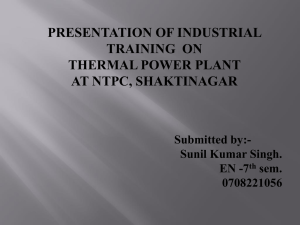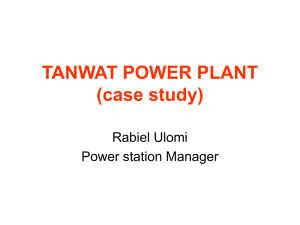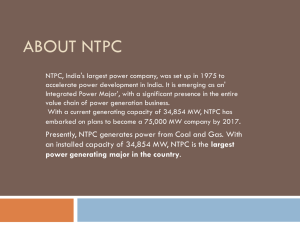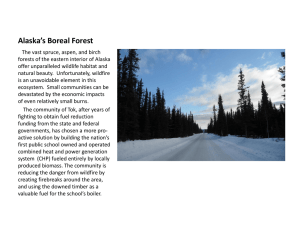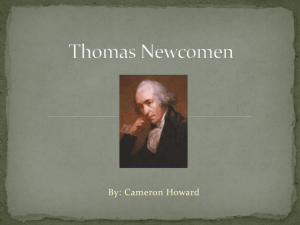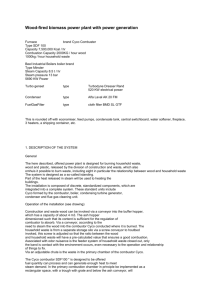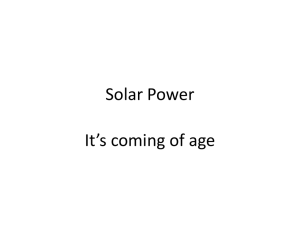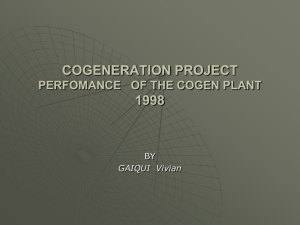EET-323 (2)-POWER PLANT ENGG
advertisement
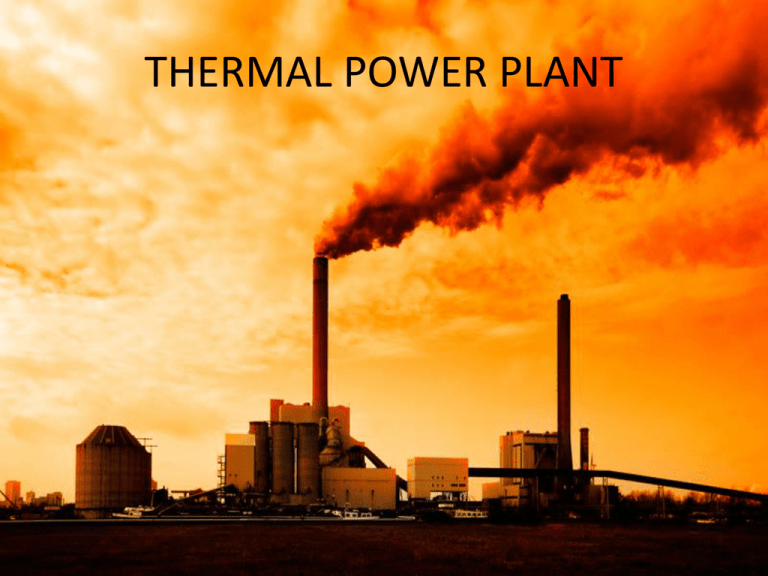
THERMAL POWER PLANT Thermal Power Stations • Coal Fired – Turbo alternators driven by steam turbine • Oil Fired – Crude oil OR Residual oil • Gas Fired – Fastest growing primary fuel, worldwide – Combined cycle • First stage - Gas turbine & Second stage - Steam Turbine • Diesel Fired – IC Engine as prime mover – Standby power plants Selection of site • • • • • • • • Nearness to load center Supply of water Availability of coal Land requirement Type of land Labour supplies Ash disposal Distance from populated area thermodynamic cycle • a type of steam engine involving a continuous cycle of vaporization of liquid and condensation back to liquid in a sealed system merits & demerits • Merits: • Fuel used is cheaper • Cheaper installation cost comparatively • Cheaper production cost in comparison with diesel power plant • Can be installed at ay place irrespective of the existence of fuels unlike HEPP • Can be located near to load center unlike HEPP • Able to respond rapidly changing loads without difficulty • Steam engines and turbine can work under under 25% of over load continuously • Portion of steam raised can be used as process steam in various industries (paper mills, textile mills etc) Merits & Demerits • • • • • • Demerits: High maintenance and operating cost Pollution Requirement of water in huge quantity Handling of coal and ash is quite difficult The plant cost increases with the increases in the operating temperature and pressure • Require long time for erection and put into action • Efficiency fall rapidly below 75% of full load Schematic diagram of Coal Fired Power Plant Components 1. Cooling tower 2. Cooling water pump 3. Transmission line 4. Transformer 5. Generator 6. L.P turbine 11. H.P turbine 7. Condensate pump 12. De-aerator 8. Surface condenser 13. Feed water heater 9. I.P turbine 14. Coal conveyor 10. steam control valve 15. Coal hopper 16. Coal pulverizer 17. Boiler steam drum 18. Bottom ash 19. Super-heater 20. Forced draught 21. Re-heater 22. Combustion 23. Economizer 24. Air pre-heater 25. Precipitator 26. Induced draught 27. Flue gas stack Fuel & Ash Handling • • • • • • • • Coal delivery: by trucks, wagons etc Coal storage: Dead & Live storage Crusher: coal is crushed to increase the area Magnetic separator: removes impurities Pulverizer: device to transform coal into fine powder Ash pit: when fuel gets burnt, ash is collected in ash pit Ash quenching: Ash is hot & dusty, hence needs to be quenched Ash delivery: Quenched ash is taken using conveyors to the site Furnace • A place where fuel is burnt • Encloses burning equipments Types • Grate fired: uses stationary or movable grates, suited for solid fuels. 1. Hand fired – uses stationary grate, small size plants, discontinuous process 2. Stoker fired – uses movable grate, medium & large size plants, continuous process . Over feed stoker: the fuel & air move are not in the same direction . Under feed stoker: the fuel & air move in the same direction • Chamber fired: suited for pulverized coal, liquid or gaseous fuels. Boiler • Water tube boiler: DM water circulates through tubes & hot flue gases flow over them. Less liable to explosion, produce high pressure steam, high efficiency, heating surface is large • Fire tube boiler: hot flue gases pass through the tubes which are surrounded by water. Low cost, compact in size, heating surface is small, cannot produce high pressure steam, liable to explode, low efficiency Water tube boiler Fire tube boiler Methods to improve thermal efficiency • Air pre-heater : hot flue gases are used to pre-heat the air pre-heats the air to be supplied to the furnace Accelerates combustion • Economizer : hot flue gases are used to heat the feed water Improves efficiency Reduces heat losses of flue gas Reduces fuel consumption • Super heater : Increases temperature of generated steam High thermal efficiency Avoids corrosion of turbine blades • Re-heaters : Exhaust Steam from hp turbine is expanded High turbine efficiency as the stages increase CONDENSER Types Surface condenser No direct contact between steam & cooling water Impure water can be used for cooling Low running cost , high vacuum is obtained Increased efficiency Requires large space High initial cost Jet Condenser Direct contact between steam & cooling water Low initial cost Compact Low efficiency Impulse -H.P turbine And Reaction - L.P & I.P turbine TYPES OF TURBINE Cooling towers • • • • • • To reduce thermal pollution which occurs in open system To cool water coming out of the condenser in a closed system Water cooled, Air cooled cooling towers Uses either natural draft or mechanical draft Natural draft – utilizes buoyancy large space, high cost, less efficient Mechanical draft uses fan, requires less space, improves efficiency Forced draft tower: blower type fan is located at the base of the tower & forces air into the tower Induced draft tower: fan is located at the top of the tower & pulls air through the tower. The fan induces hot moist air out the Contd.. • Different types of cooling towers Induced draft Draught • Draught : difference between absolute gas pressure & the ambient atmosphere pressure. If Patm< Pg as draught is positive & Patm>Pgas draught is negative Types of Draught: Natural & Mechanical • Natural draft is subjected to outside air conditions and temperature of flue gases leaving the furnace, as well as the chimney height. All these factors make proper draft hard to attain and therefore make mechanical draft equipment much more economical. • Mechanical draft: reduces chimney height, independent of weather condition, easy control Induced draft: This is obtained by simply using an induced draft fan (ID fan) which removes flue gases from the furnace and forces the exhaust gas up the stack. Almost all induced draft furnaces operate with a slightly negative pressure. Forced draft: Draft is obtained by forcing air into the furnace by means of a fan (FD fan) and ductwork. Forced draft furnaces usually have a positive pressure & use under fed stoker firing. Balanced draft: Balanced draft is obtained through use of both induced and forced draft. This is more common with larger boilers . The induced draft fan works in conjunction with the forced draft fan allowing the furnace pressure to be maintained slightly below atmospheric. ELECTROSTATIC PRECIPITATOR Fuel and ash handling Governing system Functions: • To maintain constant shaft speed at all loads • To maintain constant steam flow through turbine • To maintain constant pass out and inlet/outlet steam pressures at all flows Methods of governing: • Throttle governing • Nozzle control governing • By-pass governing • Fly ball speed governing etc Governing system

